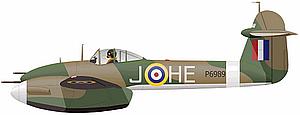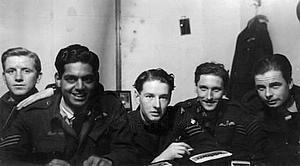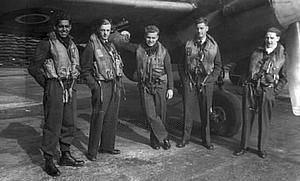Sayanapuram Duraiswamy Thyagarajan, who was known as “Tiger” Rajan, was one of the rare breed of Indian pilots who was joined the Royal Air Force in UK directly. Tiger Rajan would make his mark flying Whirlwind fighters and then Typhoons. His life was lost on the front lines over France – and he is remembered with gratitude by three different nations – India, Great Britain and France.
| Two months before his fatal sortie – The members of 263 Squadron pose for a ‘Sqn Portrait’ in June 1944, with “Tiger” taking the position on the Typhoon’s engine cowl. | 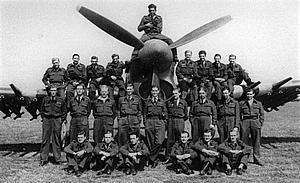 |
There was a strangely persistent — but entirely appropriate — French influence through the short life, sudden death and 62-year interim following the burial of Pilot Officer Sayana Puram Duraiswamy Thyagarajan, a Royal Air Force officer killed in World War II.
He grew up in Pondicherry, India, where the early colonial influence was so strong that the French tricolour only came down for the last time on October 31, 1950, four years before France officially handed over the territory to the now-independent nation. And he was on a mission over France on August 25, 1944, when he was shot down. It is a significant date, for it was the very day that Paris was liberated and General Charles de Gaulle led the victory parade down the Champs Elysees.
He was buried in the little village of La Lande St. Léger in Normandy, where his Typhoon fighter crash-landed. For six decades, his grave has been tended by locals in the area, which is 65 kilometres north-west of Evreux. Now he is to be honoured with a special plaque, to be unveiled near his resting place on June 2 next year, in the presence of the Indian ambassador to France and ex-RAF World War II veterans. My interest in this amazing story was kindled by an email forwarded to me 10 days ago by Jagan Pillarisetti, The original email was from Bertrand Goucovitch, the secretary of the Association pour le Souvenir des Ailes de la Victoire in Normandy. The association wanted to find out if the Indian pilot had any surviving blood relatives who could possibly be present at the unveiling of the plaque.
Who was this pilot, who spent his childhood on French soil in India, who fought in a British uniform for the liberation of France and who died in rural France on a day of pride and celebration in Paris?
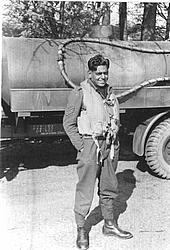 |
Sayanapuram Duraiswamy Thyagarajan as a Sgt with No. 263 Squadron when he flew Westland Whirlwinds (below) between 20th October 1942 and 25th May 1943. His parents were avid followers of Sri Aurobindo in Pondicherry and it is said he joined the RAF answering Aurobindo’s call to resist fascism with all means. |
| Another photo of Thyagarajan (Center) with No 263 Squadron, RAF, The aircraft is a Westland Whirlwind (P7094 HE-T) .
The CO Flt Lt Geofferey B Warnes is second left and the Adjutant , F/L EC Owens is at first left . Other pilots in the Squadron are Canadian, Austarlian and West Indian. |
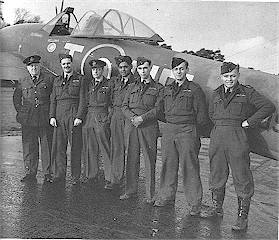 |
He was known simply as Tiger, not surprisingly. It was — and still is — a logical nickname for a fellow whose name would have been unpronounceable in wartime, pre-multicultural Britain. To his fellow officers at 263 Squadron, Thyagarajan would simply have been Tiger Rajan.
His resting place is unique in many respects. As Bertrand pointed out to me in a rapid exchange of emails, his gravestone is uncommon because it has an inscription in three languages — Hindi, English and French. And his burial spot, near the south wall and the small entrance gate, is the only serviceman’s grave in the cemetery. It is a strange distinction in France, where thousands of military remains (many of them dug up and re-interred) are meticulously recorded and maintained by the Commonwealth War Graves Commission.
Thanks to Bertrand’s efforts, we were able to get a first-hand account of Tiger’s last moments.
He was flying a Hawker Typhoon, a gutsy aircraft used in a low-level attack role. Generally armed with rockets to complement its wing-mounted cannons, the sturdy Typhoon was crucial to the Allies’ ground attack strategy. It is thought that Tiger’s mission was to attack an armoured column and while details are sketchy, it seems his aircraft was heavily hit by hostile fire.
Claude Roussel was only 13 years old when he watched Tiger’s stricken Typhoon hit the ground. He said the pilot had tried to force-land the fighter. “He hit a row of poplar trees and the aircraft flipped upside down, blowing up in an orchard. When the village priest went to the crash site, British soldiers had retrieved the pilot’s body and were burying him on the scene as the village was liberated by the Allies only the day before. The priest stopped the soldiers and said that the pilot should instead be properly honoured by being buried in the churchyard nearby.”
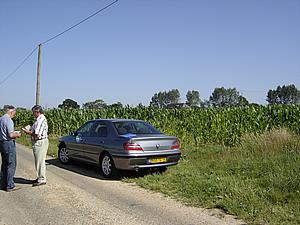 |
Thyagarajan was killed over France at this very spot at the La Lande St. Léger in Normandy on 26th August 1944. Commonwealth War Graves Commission Certificate |
| Tiger’s final resting place: The church cemetary in the little village of La Lande St. Léger in Normandy, is where Thyagarajan is buried. His grave is the only CWGC maintained grave in the village. |  |
 |
Claude Roussel (on left) was only 13 years old when he watched Tiger’s stricken Typhoon hit the ground. He is seen here along with Mr. Jacques Bréhin, President ASAVN. The ASAVN hopes to get all the surviving Squadron members of 263 in 2007 for a plaque unveiling ceremony at the Noyers-Bocage Typhoon Memorial. |
| The grave’s headstone with the Hindi, English and French inscriptions. It is very rare to find a Hindu headstone almost without exception in any CWGC Cemetery, This was because all Indian soldiers of Hindu and Sikh faith who were killed-in-action were cremated and the names commemorated on a memorial. | 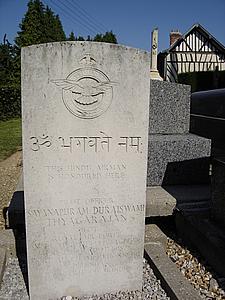 |
A few hours after Jagan’s first email, came a clear but poignant reminder of the power of the Internet. Even before a decision could be taken about which paper an advertisement should be placed in to track down Tiger’s family, came an email from Wing Commander (Retd.) D.P. Soni, formerly of the Indian Air Force office. “I have been known to the Duraiswamy family since 1960,” the email said. “I used to hear about Tiger from his parents during my visits to Sri Aurobindo Ashram in Pondicherry (1958-1964) while I was with 4 Squadron, flying Toofanis. How often I was treated to breakfast or lunch and enjoyed their kind hospitality. I knew I was being seen in the shadow of Tiger whom I had never met or seen. He only lived in my imagination.” Fittingly, it was D.P. Soni who tracked down Tiger’s only living relative, his sister — whose name I have, but shall not publish because she is 94 — in New Delhi. Soni modestly deflected praise from other former Air Force officers who expressed amazement that he had found Tiger’s sister so swiftly. “For me this was a privilege and honour to be useful in honouring Tiger’s memory,” was all he said in response. It was, I guess, the ultimate humble tribute from one pilot to another.
